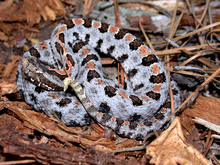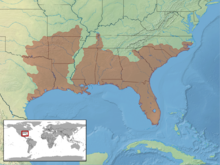పిగ్మీ రాటిల్ స్నేక్
| పిగ్మీ రాటిల్ స్నేక్ | |
|---|---|

| |
| శాస్త్రీయ వర్గీకరణ | |
| Kingdom: | Animalia
|
| Phylum: | |
| Subphylum: | |
| Class: | |
| Order: | |
| Suborder: | |
| Family: | |
| Subfamily: | |
| Genus: | |
| Species: | S. miliarius
|
| Binomial name | |
| Sistrurus miliarius (Linnaeus, 1766)
| |

| |
| Synonyms | |
| |
- సాధారణ పేర్లు: గ్రౌండ్ రాటిల్ స్నేక్, పిగ్మీ రాటిల్ స్నేక్, లీఫ్ రాటిల్, డెత్ రాతిల్, తూర్పు పిగ్మీ రాటిల్ స్నేక్[3]
సిస్ట్రరస్ మిలియారిస్ దక్షిణ యునైటెడ్ స్టేట్స్ లో గల విషపూరిత సర్పజాతి. దీనిలో మూడు ఉపజాతులను ప్రస్తుతం ఇక్కడ గుర్తించబడినవి[4]
వివరణ[మార్చు]

ఈ చిన్న జాతి యొక్క వయోజన పాములు సుమారు 40–60 cm (16–24 in) పొడవు పెరుగుతాయి. అద్యధికంగా వీటి పొడవు 78.8 cm (31.0 in) (క్లాబర్, 1972) గా నమోదయినది. స్నెల్లింగ్, కొల్లీన్స్ (1997) లో ఎస్.ఎం.బార్బోరీ అనే జాతిని 80.3 cm (31.6 in)గా నమోదు చేసారు. కానీ అది 12 సంవత్సరాలుగా నిర్భంధంలో ఉంది. 1940లో గ్లోయిడ్ పెద్దదైన ఎస్.ఎం. బార్బోరీని కనుగొని దాని పొడవును 63.8 cm (25.1 in) గా నమోదు చేసాడు. దీనిని ఫ్లోరిడా లోని సెయింట్ పీటర్స్ బర్గ్ లో కనుగొన్నాడు. 1978లో షైన్ "కొన్ని పాముల జనాభాలో పురుష జాతులు స్త్రీ జాతుల కన్నా ఎక్కువ పొడవు ఉండవచ్చు"నని సూచించాడు. కానీ తర్వాతి కాలంలో 1996లో బిషప్ ఎట్ ఆల్ అధ్యయనం ఆధారంగా ఫ్లోరిడాలోని వోలుసియా దేశంలో వాటి జనాభాకు సంబంధించిన సెక్సువల్ డిమార్ఫిజం కనుగొనబడలేదని తెలిసింది.[5] ఈ పాము మధ్య దేహం వరుసలలో డోర్సల్ స్కేల్స్ సుమారు 23 ఉంటాయి. ఈ డోర్సల్ పాటర్న్ లలో వరుసగా ఓవల్ ఆకారంలో లేదా అర్థ వృత్తాకారంలో మచ్చలు క్రమాకారమైన అంచులతో కూడి ఉంటాయి. వీటి పార్శ్వాలలో మచ్చలు సాధారణంగా వృత్తాకారంగా పెద్దవిగా ఉంటాయి. వెనుక వైపు బెల్లీ పిగ్మెంటేషన్ అనేది ప్రక్కనే ఉన్న కణాల జతలలో కనిపించని స్పష్టమైన మచ్చలతో ఉంటుంది.[3] యువసర్పాలకు పెద్దలకు పోలివున్న రంగు నమూనాను కలిగి ఉంటాయి, అయితే ఇది పాలిపోయిన లేదా మరింత స్పష్టంగా గుర్తించబడినప్పటికీ దాని తోక యొక్క కొన పసుపు రంగులో ఉంటుంది.[5]
సాధారణ నామాలు[మార్చు]
బస్ట్రార్డ్ రాటిల్ స్నేక్, నిప్పిల్ స్నేక్, కారోలినా గ్రౌండ్ రాటిల్ స్నేక్, బ్రిక్ రెడ్ రాటిల్ స్నేక్, కారోలినా పిగ్మీ రాటిల్ స్నేక్, కాటెస్బీ స్మాల్ స్నేక్, డ్వార్ఫ్ రాటిల్ స్నేక్, ఈస్టర్న్ పిగ్మీ రాటిల్ స్నెక్, గ్రే రాటిల్ స్నేక్, గ్రౌండ్ రాటిల్ (జర్నం 1887), గ్రౌండ్ రాటిల్ స్నేక్, హాగ్-నోస్డ్ రాటిల్ స్నేక్, లిటిల్ రాటిల్ స్నేక్, మిలియరీ రాటిల్ స్నేక్, నార్త్ అమెరికన్ స్మాలర్ రాటిల్ స్నేక్, ఓక్-లీఫ్ రాటిల్, పిగ్మీ గ్రౌండ్ రాటిల్ స్నేక్, పిగ్మీ రాటిల్ స్నేక్, స్మాల్ రాటిల్ స్నేక్, స్పాటెడ్ రాటిల్ స్నేక్[3] సదర్న్ రాటిల్ స్నేక్.[6]
భౌగోళిక పరిధి[మార్చు]
ఇవి ఆగ్నేయ యునైటెడ్ స్టేట్స్ లో ఉంటాయి. ఇవి ఉత్తర కాలిఫోర్నియాలోని దక్షిణ, తూర్పు ప్రాంతం, ఫ్లోరిడా ద్వీపం దక్షిణ ప్రాతం, పశ్చిమ నుండి తూర్పు టెక్సాస్, విస్తరించబడి ఉంటాయి.[2]
అలవాటు[మార్చు]
ఈ జాతులు ప్లాట్ ఉడ్స్, ఇసుక కొండలు, మిశ్రమ అడవులు, వరద మైదానాలలో నివసిస్తాయి. ఇవి సరస్సులు, చిత్తడినేలలు సమీపంలో కూడా నివసిస్తాయి.[2]
పరిరక్షణ స్థితి[మార్చు]
ఈ జాతులు తక్కువ పరిరక్షణ గల వాటిగా వర్గీకరింబబడ్డాయి.[1] అవి విస్తృత పంపిణీ, పెద్ద జనాభాగా భావించడం లేదా మరింత ప్రమాదకరమైన వర్గంలోని జాబితాకు అర్హత పొందటానికి తగినంత వేగం తగ్గిపోవటానికి అవకాశం లేకపోవడం కారణంగా ఆ జాబితాలో చేర్చారు. వీటి జనాభా స్థిరత్వంగాఉంది. సంవత్సరం అంచనా: 2007.[7]
ప్రవర్తన[మార్చు]
వేసవి కాలంలో ఎండలో తమంతట తామే సాయంత్రంపూట రోడ్డుదాటుతాయి. చిన్న రాటిల్ స్నేక్స్ బజ్జింగ్ శబ్దాన్ని చేసూంటాయి. దీ శబ్దాన్ని కొన్ని అడుగుల వరకు వినవచ్చు. కొన్ని పాములు కోపంతో కూడిన దూకుడుగా ప్రవర్తిస్తాయి.[8][9] వాటి బొరియలను అవే త్రవ్వుకోవు కానీ ఎలుకలు లేదా గోఫర్ తాబేళ్లు కట్టుకొనే బొరియలను వాటి ఆవాసాలుగా వినియోగిస్తాయి.[10][11]
ఆహారం[మార్చు]
ఇవి చిన్న క్షీరదాలైన పక్షులు, బల్లులు, కీటకాలు, కప్పలను తిని జీవిస్తాయి.[3] అదే విధంగా యితర పాములను కూడా భక్షిస్తాయి.[8][9]
Venom[మార్చు]
Since this species is unable to produce much venom, it is unlikely that it is able to deliver a fatal bite to a human adult.[12] Brimley (1942) wrote that although it was too small to be really dangerous, its bite "will give the victim quite an unpleasant time for several days."[3] However, bites involving children have resulted in prolonged hospitalization and there are also reports of necrosis.[12]
These snakes produce cytotoxic venom that is strongly hemorrhagic and tissue toxic, but devoid of any neurotoxins (Ernst, 1992; Van Mierop, 1976). The venom was basis for the development of the drug eptifibatide which is used to prevent clotting during a heart attack. The venom is somewhat different in that it contains substantial amounts of serotonin and related tryptamine compounds (Welsh, 1967). Antivenin does not appear to be effective in the treatment of these bites, although CroFab does seem to do a better job than ACP, at least in some animal models. (Consroe et al., 1995).[12]
Subspecies[మార్చు]
| Subspecies[4] | Taxon author[4] | Common name[13] | Geographic range[13] |
|---|---|---|---|
| S. m. barbouri | Gloyd, 1935 | Dusky pygmy rattlesnake | The United States from extreme southern South Carolina through southern Georgia, all of Florida, west through southern Alabama and southeastern Mississippi. |
| S. m. miliarius | (Linnaeus, 1766) | Carolina pygmy rattlesnake | The United States from extreme southern South Carolina, northwards into eastern North Carolina as far as Hyde County and west through central Georgia and central Alabama. |
| S. m. streckeri | Gloyd, 1935 | Western pygmy rattlesnake | The United States in Mississippi (except for southeast of the Pearl River Valley), west through Louisiana into eastern Texas, and north into southeastern Oklahoma, Arkansas, southern Missouri and southwestern Tennessee. |
మూలాలు[మార్చు]
- ↑ 1.0 1.1 మూస:Redlist species
- ↑ 2.0 2.1 2.2 McDiarmid RW, Campbell JA, Touré T. 1999. Snake Species of the World: A Taxonomic and Geographic Reference, vol. 1. Herpetologists' League. ISBN 1-893777-00-6.
- ↑ 3.0 3.1 3.2 3.3 3.4 Wright AH, Wright AA. 1957. Handbook of Snakes. Comstock Publishing Associates. (7th printing, 1985). 1105 pp. ISBN 0-8014-0463-0.
- ↑ 4.0 4.1 4.2 "Sistrurus miliarius". Integrated Taxonomic Information System. Retrieved 28 February 2007.
- ↑ 5.0 5.1 Campbell JA, Lamar WW. 2004. The Venomous Reptiles of the Western Hemisphere. Comstock Publishing Associates, Ithaca and London. 870 pp. 1500 plates. ISBN 0-8014-4141-2.
- ↑ U.S. Navy. 1991. Poisonous Snakes of the World. US Govt. New York: Dover Publications Inc. 203 pp. ISBN 0-486-26629-X.
- ↑ మూస:Redlist CC2001
- ↑ 8.0 8.1 Behler JL, King FW. 1979. The Audubon Society Field Guide to North American Reptiles and Amphibians. New York: Alfred A. Knopf. 743 pp. LCCCN 79-2217. ISBN 0-394-50824-6.
- ↑ 9.0 9.1 Conant R. 1975. A Field Guide to Reptiles and Amphibians of Eastern and Central North America. Second Edition. First published in 1958. Houghton Mifflin Company Boston. 429 pp. 48 plates. ISBN 0-395-19979-4 (hc), ISBN 0-395-19977-8 (pb).
- ↑ Animal Diversity-U. of Michigan (Downloaded Feb. 18, 2010.)
- ↑ Ernst, C., R. Barbour. 1989. Snakes of Eastern North America. Fairfax, Virginia: George Mason University Press.
- ↑ 12.0 12.1 12.2 Norris R. 2004. Venom Poisoning in North American Reptiles. In Campbell JA, Lamar WW. 2004. The Venomous Reptiles of the Western Hemisphere. Comstock Publishing Associates, Ithaca and London. 870 pp. 1500 plates. ISBN 0-8014-4141-2.
- ↑ 13.0 13.1 Klauber LM. 1997. Rattlesnakes: Their Habitats, Life Histories, and Influence on Mankind. Second Edition. First published in 1956, 1972. University of California Press, Berkeley. ISBN 0-520-21056-5.
ఇతర లింకులు[మార్చు]
- Sistrurus miliarius Archived 2016-03-04 at the Wayback Machine at University of Texas - Herps of Texas Archived 2012-07-17 at the Wayback Machine. Accessed 30 November 2006.
- The Pigmy Rattlesnake Homepage (Sistrurus miliarius) at Stetson University Biology Department. Accessed 30 November 2006.
- ISBN మ్యాజిక్ లింకులను వాడే పేజీలు
- IUCN Red List least concern species
- Articles with 'species' microformats
- Taxobox articles missing a taxonbar
- Commons link is on Wikidata
- Sistrurus
- Reptiles of the United States
- Fauna of the Southeastern United States
- Taxa named by Carl Linnaeus
- Animals described in 1766
- ఐ.యు.సి.ఎన్. కనీస ఆందోళనకర ఎర్ర జాతులు జాబితా
